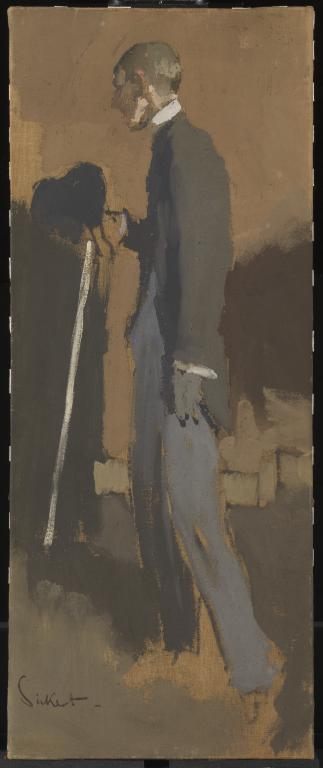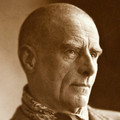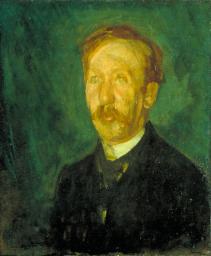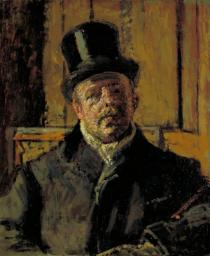Walter Richard Sickert Aubrey Beardsley 1894
Walter Richard Sickert,
Aubrey Beardsley
1894
Walter Sickert’s portrait presents his fellow artist Aubrey Beardsley in elongated profile, turning away from the viewer with walking stick in hand. The two were good friends, despite their artistic differences. At the time this portrait was made Beardsley was well known for his decadent and sensual illustrations. The narrow, upright format of this painting echoes the late portraits of Whistler, with whom Sickert had studied.
Walter Richard Sickert 1860–1942
Aubrey Beardsley
1894
Tempera on canvas
762 x 311 mm
Inscribed by the artist ‘Sickert’ bottom left
Purchased (Grant-in-Aid), with the assistance of the National Art Collections Fund 1932
N04655
1894
Tempera on canvas
762 x 311 mm
Inscribed by the artist ‘Sickert’ bottom left
Purchased (Grant-in-Aid), with the assistance of the National Art Collections Fund 1932
N04655
Ownership history
Mrs Ellen Agnus Beardsley (1846–1932), the sitter’s mother; her sale Sotheby’s, London, 27 June 1932, bought for £300 by Tate Gallery.
Exhibition history
1895
Exhibition of Paintings and Drawings by Walter Sickert and Bernhard Sickert, Van Wisselingh’s Dutch Gallery, London, 1895 (3, as ‘Portrait of Mr Aubrey Beardsley. Sketch in Distemper’).
1960
Sickert: Paintings and Drawings, (Arts Council tour), Tate Gallery, London, May–June 1960, Southampton Art Gallery, July 1960, Bradford City Art Gallery, July–August 1960 (16).
1971
From Realism to Symbolism: Whistler and His World, Wildenstein, New York, March–April 1971, Philadelphia Museum of Art, April–May 1971 (132, reproduced pl.63).
1973
Sickert, Fine Art Society, London, May–June 1973, Fine Art Society, Edinburgh, June–July 1973 (19).
1989–90
W.R. Sickert: Drawings and Paintings 1890–1942, Tate Gallery, Liverpool, March 1989–February 1990, Tate Gallery, London, July–September 1990 (3, reproduced).
1991–2
The Portrait in British Art, National Portrait Gallery, London, November 1991–February 1992 (56, reproduced).
1992–3
Sickert: Paintings, Royal Academy, London, November 1992–February 1993, Van Gogh Museum, Amsterdam, February–May 1993 (15, reproduced).
1998
James McNeill Whistler, Walter Richard Sickert, Fundación ‘La Caixa’, Madrid, March–May 1998, Museo de Bellas Artes, Bilbao, May–July 1998 (72, reproduced).
2000–1
The Wilde Years: Oscar Wilde and the Art of his Time, Barbican Art Gallery, London, October 2000–January 2001 (162, reproduced).
2005
Walter Richard Sickert: The Human Canvas, Abbott Hall Art Gallery, Kendal, July–October 2005 (4, reproduced).
2005–6
Degas, Sickert and Toulouse-Lautrec: London and Paris 1870–1910, Tate Britain, London, October 2005–January 2006 (76, reproduced).
References
1894
The Yellow Book, vol.2, July 1894, reproduced p.220.
1924
R.R. Tatlock, ‘The Tate Gallery’, Burlington Magazine, vol.44, no.253, April 1924, p.202, reproduced pl.1A, as Portrait of Beardsley.
1928
Haldane MacFall, Aubrey Beardsley, the Man and his Work, London 1928, p.xiii.
1933
National Art-Collections Fund Twenty-Ninth Annual Report 1932, London 1933, p.47, reproduced p.46.
1939
John Rothenstein, ‘Walter Richard Sickert’, Picture Post, 18 February 1939, reproduced.
1941
Robert Emmons, The Life and Opinions of Walter Richard Sickert, London 1941, p.87.
1943
Lillian Browse and Reginald Howard Wilenski, Sickert, London 1943, pp.11, 37–8, reproduced pl.9.
1955
Anthony Bertram, Sickert, London and New York 1955, reproduced pl.6.
1960
Lillian Browse, Sickert, London 1960, p.100.
1961
John Rothenstein, Sickert, London 1961, reproduced p.2.
1964
Mary Chamot, Dennis Farr and Martin Butlin, Tate Gallery Catalogues: The Modern British Paintings, Drawings and Sculpture, vol.2, London 1964, pp.625–6.
1967
Ronald Pickvance, Sickert, London 1967, reproduced pl.1.
1971
Marjorie Lilly, Sickert: The Painter and his Circle, London 1971, p.31.
1973
Wendy Baron, Sickert, London and New York 1973, pp.37, 307, no.57, reproduced pl.40.
1977
Sickert, exhibition catalogue, Arts Council, London 1977, p.14 reproduced.
1981
Late Sickert: Paintings 1927–1942, exhibition catalogue, Arts Council, London 1981, p.91.
1987
Kenneth McConkey, Edwardian Portraits: Images of an Age of Opulence, Woodbridge 1987, reproduced pl.35.
1988
Laura Wortley, British Impressionism: A Garden of Bright Images, London 1988, reproduced p.139.
1989
‘Dandy in God’s Acre’, Hampstead and Highgate Express, 13 January 1989, reproduced.
1992
Maureen Connett, Walter Sickert and the Camden Town Group, Newton Abbott 1992, reproduced p.17.
1992
Hilton Kramer, ‘Justice to Walter Sickert’, Modern Painters, vol.5, no.4, Winter 1992, p.11.
1998
Lucien Pissarro et le post-impressionisme anglais, exhibition catalogue, Musée de Pontoise 1998, p.36.
1998
Stephen Calloway, Aubrey Beardsley, London 1998, p.121, reproduced.
1998
Matthew Sturgis, Aubrey Beardsley: A Biography, London 1998, pp.211, 214–5, 692 n.122.
2006
Wendy Baron, Sickert: Paintings and Drawings, New Haven and London 2006, no.69, reproduced.
2007
Andrew Stephenson, ‘Precarious Poses: The Problem of Artistic Visibility and its Homosocial Performances in Late-Nineteenth-Century London’, Visual Culture in Britain, vol.8, no.1, 2007, pp.87–90, reproduced p.87.
Technique and condition
Aubrey Beardsley is painted on the back of a previously used linen canvas. The opposite side has white priming and was painted in a warm brown paint that extended onto the tacking edges. It had been cut down from a larger canvas and stretched over another stretched canvas. The front face of the supporting canvas has white priming covered in a dark grey layer that, like the brown layer on the top canvas, is probably oil paint. There is no visible evidence of any image on either canvas. The supporting canvas has never been removed from its stretcher and was originally supplied by the artists’ colourmen L. Cornelissen & Son, whose stamp marks the back of the cloth.
Sickert has painted this portrait directly onto the raw canvas in what is most likely a gouache medium. The cloth has a relatively open weave and the white oil primer can be seen through the weave interstices. Analysis of the paint confirms the absence of oil or other non-aqueous media and although the amount of medium is small, the evidence for gum is the strongest.1 The dried paint film appears matt from the lean medium and absorbent support, and visible on the surface are air bubbles made from vigorous stirring or brushing of the paint when wet. The colours used include bone black, red ochre, brown ochre and chalk, which is used on its own as the main white pigment.2 All have a high content of chalk and other extenders such as silica, kaolin and gypsum suggesting that it is a less expensive paint; it is possible that Sickert was using colours made for painting theatrical backdrops.
There is some initial rough drawing in black paint, which is readily visible where it has not been covered. The paint has been diluted with water but brushed onto the canvas sufficiently thickly to reduce some of the canvas weave texture. The paint is mostly applied directly onto the canvas, in broad patches or washes, with no evidence of any preparation other than the colourmen’s canvas sizing. There are large unpainted areas of canvas and the background is a light brown colour, which probably approximately matches the original colour of the cloth. The canvas has darkened a little since then and is now seen as a separate field through the work and in the unpainted extremities between each patch of colour. There is little modulation of the paint and, in general, the main areas of colour are placed next to each other and do not deliberately merge or overlap. The blue trousers, grey coat, black hat and brown background shapes are all painted with little modulation. Details, such as the white cane, collar and sleeve, which are applied over areas of earth colours, necessarily form the thickest areas of paint. The surface is unvarnished, retaining the matt aesthetic of the painting.
Stephen Hackney
December 2004
Notes
How to cite
Stephen Hackney, 'Technique and Condition', December 2004, in Robert Upstone, ‘Aubrey Beardsley 1894 by Walter Richard Sickert’, catalogue entry, May 2009, in Helena Bonett, Ysanne Holt, Jennifer Mundy (eds.), The Camden Town Group in Context, Tate Research Publication, May 2012, https://wwwEntry
Aubrey Vincent Beardsley was born in Brighton, Sussex, on 21 August 1872. He became one of the most distinctive and innovative artists of the 1890s, developing a highly original style of pen and ink illustration. Beardsley relished subjects that played with grotesque or erotic material, and his drawings acquired a reputation for their decadence and sensuality. His work gained widespread prominence in April 1893 when a number were reproduced in the first issue of Studio, a new progressive art journal, for which he also designed the first cover. In 1894 he was appointed as the art editor of the Yellow Book, a publication that showcased aesthetic writing and art; also that year his shocking illustrations to Oscar Wilde’s Salome appeared. In the wake of Wilde’s trial in 1895, Beardsley was sacked from Yellow Book. In partnership with the publisher Leonard Smithers, many of Beardsley’s drawings became increasingly outrageous, typified by the playfully pornographic Lysistrata series and his fetishistic designs for The Sixth Satire of Juvenal, which both appeared in 1896. But at the same time Beardsley also evolved a refined and inventive reworking of French rococo style in such series as The Rape of the Lock (1896) and Volpone (1898). Beardsley suffered from tuberculosis throughout his life, and in 1898 it finally killed him at the age of twenty-five.1
When Sickert made this painting, Beardsley was extremely well known. The first volume of the Yellow Book had appeared in April 1894 and Beardsley was at work on the Salome illustrations, which secured him both fame and notoriety. It has long been thought that the inspiration for Sickert’s picture was the sight of Beardsley walking away from the unveiling of the monument to the poet John Keats in Hampstead Church in July 1894.2 In purple prose, Haldane Macfall recalled in his 1928 book on Beardsley:
There had foregathered in the church on the hill for the occasion the literary and artistic world of the ‘nineties. As the congregation came pouring out of the church doors, a slender, gaunt young man broke away from the throng, and, hurrying across the graveyard stumbled and lurched awkwardly over green mounds of the sleeping dead. This stooping, dandified being was evidently intent on taking a short-cut out of God’s acre. There was something strangely fantastic in the ungainly efforts at a dignified wayfaring over the mound-encumbered ground by the loose-limbed, lank figure so immaculately dressed in black cut-away coat and silk hat, who carried his lemon-yellow kid gloves in his long white hands ... He took off his hat to some lady who called to him, showing his ‘tortoiseshell’ coloured hair, smoothed down ... He stooped and stumbled so much and so awkwardly amongst the sleeping dead that I judged him short-sighted; but was mistaken – he was fighting for breath.3
However, it is impossible that this incident was the source for Sickert’s picture. The Keats ceremony took place on 16 July 1894 and the painting was reproduced in the second volume of the Yellow Book just days afterwards. The precise date of publication is unknown, but the Times reviewed it on 20 July in the column ‘Books of the Week’.4 However swiftly Sickert’s picture was painted, it would have been impossible for it to be photographed and go through the processes of print setting and page proofing to be reproduced in a bound book so quickly.
Indeed, Macfall’s vivid account seems so close to the picture that, written nearly thirty-five years after the ceremony in Hampstead, it seems almost as if he is describing Sickert’s painting itself, and it may well be that his memory was coloured by it.5 When writing the monograph, he might easily have seen the picture when visiting Beardsley’s mother, and he would certainly have been familiar with it through the Yellow Book reproduction. The claim that the picture depicts Beardsley picking his way through a graveyard is also likely to be erroneous. There is, in fact, no indication it is an outdoor scene at all, and could just as likely be indoors, supported by Beardsley not having donned his hat. The viewpoint of the painting is very low, as if Sickert were seated. It seems possible that the painting was the result of the visit that produced Sickert’s drawings of Beardsley, for one of which both artists were seated (see below).
Sickert and Beardsley became good friends in the early 1890s. Encouraged by Frederick Brown, his teacher at Westminster School of Art, Beardsley showed at the New English Art Club for the first time in April 1893, sending a japoniste drawing, La Femme incomprise 1892 (private collection).6 He quickly came to be on affable terms with several of the other exhibitors,7 and became part of a group who discussed art on Sunday mornings at Philip Wilson Steer’s studio in Cheyne Walk, Chelsea; here his friendship with Sickert flourished.8 Beardsley’s companionship with the impressionist cadre of the New English Art Club may seem surprising, as his work is so different. Indeed, he once commented waspishly, ‘How few of our young English impressionists knew the difference between a palette and a picture! However, I believe that Walter Sickert did – sly dog!’9
It appears that Sickert offered to show Beardsley how to paint in oils, and it is possible that Beardsley’s Masked Woman with a White Mouse c.1894 (verso, Tate N03815) might have been made partly under Sickert’s instruction. In the ‘Revised Iconography’ of Beardsley’s work published in 1909, Aymer Vallance wrote of the picture: ‘Three-quarter figure in leaden grey. Unfinished painting in oils, the only experiment the artist ever made in this medium; influenced by Walter Sickert. c.1894.’10 In a letter to the author, Beardsley’s biographer Matthew Sturgis has written:
It is hard to be sure whether the reference to Sickert’s ‘influence’ is a posthumous art-historical judgment or a statement of biographical fact. I rather favour the latter ... Vallance certainly knew Beardsley well, and, when compiling his iconography, drew on the recollections of friends and contemporaries (quite possibly including Sickert, who is referred to elsewhere in the text).11
Further evidence comes, Sturgis points out, from R.A. Walker’s book Some Unknown Drawings of Aubrey Beardsley (1923). The book is unpaginated, but the first work is A Caprice, the oil painting on the other side of Masked Woman with a White Mouse. Walker comments on the double-sided painting:
Both paintings are very low in colour, which time has certainly not heightened, and possibly for that reason Mr. Vallance has described the picture as influenced by Mr. Walter Sickert. However, Mr. Sickert himself, although admiring ‘A Caprice’, has told me he thinks it was executed more under the influence of Mr. William Nicholson, though he admits having offered to teach Beardsley to paint.12
Sickert’s comparison of A Caprice to William Nicholson’s work seems wilfully inaccurate, as the few oils Nicholson produced in the 1890s bear little similarity. But there are certain resonances with an uncharacteristic work by Sickert himself. Sturgis writes:
There is, however, a passing connection between ‘A Caprice’ and Sickert’s 1893 painting (now lost) of the ‘Hotel Royal, Dieppe’,13 which he exhibited at the NEAC’s winter show that year. The foreground is filled with figures in vast, improbably stylised crinolines. The effect, at the time, was considered very strange indeed. Sickert’s sister-in-law thought it ‘simply absurd’.14
Beardsley evidently admired Sickert’s work and chose him as one of the illustrators for the Yellow Book and later the Savoy. Plainly he was pleased with Sickert’s portrait of him, as he wrote to Leonard Smithers that he wanted it to be included in A Book of Fifty Drawings (1897), the first collection of Beardsley’s drawings that was published.15
The first recorded owner of Sickert’s portrait was Beardsley’s mother Ellen Agnus Beardsley (1846–1932). She inherited Beardsley’s Estate, and it may originally have been given to her son by Sickert. But Ellen and Sickert were also on friendly terms – he visited her when she was recuperating from an operation, for instance16 – and it is quite possible that he presented it to her or to mother and son jointly. Beardsley lived with his mother almost all his life, and so making precise distinctions in ownership may in any case be irrelevant. It seems possible the picture was a gift rather than a purchase because of the friendship between Sickert and the Beardsleys. Beardsley is known to have presented one of his drawings to Sickert, a caricature of James Abbott McNeill Whistler: when Whistler failed to arrive at a dinner in Paris in 1893, Joseph Pennell recalled that Beardsley made a caricature of him sitting on a bench pointing at a butterfly (National Gallery of Art, Washington).17 Pennell said Beardsley offered the drawing to him when it was finished, but ‘Walter Sickert got it, said he left it in a cab’.18 An alternative story has it that Beardsley decorated his Christmas tree with unusual items, including a caricature of Whistler – a fact confirmed in a letter he wrote to André Rafflovich in 189619 – and that Sickert carried it off as his Christmas present.20 Beardsley expert Linda Zatlin suggests that the considered technique of this drawing makes it an unlikely candidate for a caricature done at a dining table, and instead suggests that what Sickert may have been given was a caricature of Whistler in Beardsley’s ‘bon mot’ style (Princeton University Library).21
Around the same time Sickert made his painting of Beardsley, he is known to have also made at least two drawings of him, neither of which, however, is a study. There is a head and shoulders, half-turned profile drawing in the National Portrait Gallery c.1894,22 and also an untraced portrait of Beardsley leaning his head against his hand and holding a walking stick. The latter was reproduced as the frontispiece of Hans von Weber’s Aubrey Beardsley: Briefe (1908), the writer incorrectly attributing the drawing’s authorship to Beardsley himself. It is this work that Sickert described in 1911 in his article about attribution, ‘L’Affaire Greaves’:
I did a drawing of Beardsley in an armchair in Cambridge Street.23 A German collector cherishes it as a Beardsley, and when Arthur Symons pointed out that ‘Sickert’ was written in the corner, the German authorities said: ‘Ah! yes we know; but Beardsley wrote that to indicate he was ill, was at his sickest.’24
It is unusual for a full-length portrait, such as Aubrey Beardsley, to show the subject in the act of walking, frozen in movement; no other Sickert picture of the 1890s repeats this. However, it was something Sickert returned to later, relying on the possibility of photographs to freeze movement, and Aubrey Beardsley might be interestingly compared with much later pictures such as H.M. King Edward VIII 1936 (fig.1), showing the monarch stepping out of his car, or Gavin Henderson, 2nd Lord Faringdon c.1935 (Buscot Park Collection),25 where the figure walks down a flight of steps.
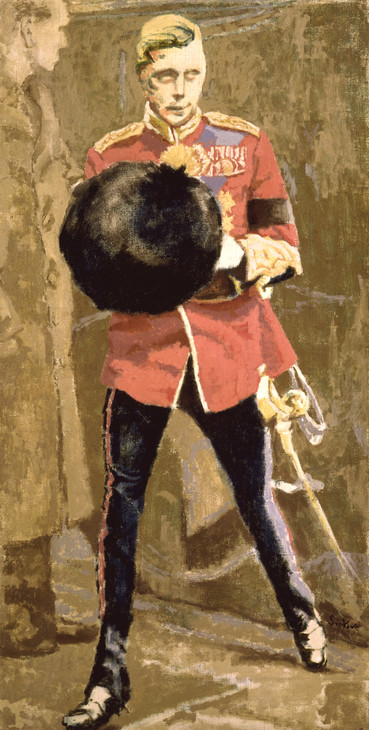
Walter Richard Sickert 1860–1942
H.M. King Edward VIII 1936
Oil paint on canvas
1834 x 921 mm
The Beaverbrook Art Gallery / The Beaverbrook Canadian Foundation (in dispute, 2004)
© Estate of Walter R. Sickert / DACS
Photo © The Beaverbrook Art Gallery, Fredericton, NB
Fig.1
Walter Richard Sickert
H.M. King Edward VIII 1936
The Beaverbrook Art Gallery / The Beaverbrook Canadian Foundation (in dispute, 2004)
© Estate of Walter R. Sickert / DACS
Photo © The Beaverbrook Art Gallery, Fredericton, NB
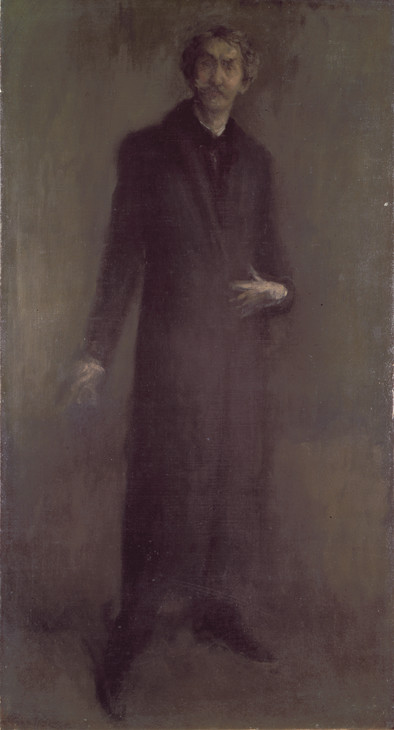
James Abbott McNeill Whistler 1834–1903
Brown and Gold: Self-Portrait c.1895–1900
Oil paint on canvas
958 x 515 mm
Hunterian Art Gallery, University of Glasgow
Photo © The Hunterian, University of Glasgow 2010
Fig.2
James Abbott McNeill Whistler
Brown and Gold: Self-Portrait c.1895–1900
Hunterian Art Gallery, University of Glasgow
Photo © The Hunterian, University of Glasgow 2010
The long, thin, upright format Sickert gave Aubrey Beardsley consciously recalls the late portraits of Whistler, such as Arrangement in Flesh Colour and Black: Portrait of Theodore Duret 1883–4 (Metropolitan Museum of Art, New York)26 and Brown and Gold: Self-Portrait c.1895–1900 (fig.2); these, in turn, were influenced by the portraits of Edouard Manet and Diego Velázquez. In the 1880s and 1890s Whistler produced a steady output of full-length works, using carefully limited colour harmonies, a subdued palette and featureless backgrounds. As in Sickert’s picture, the foregrounds in these works are short and the compositional recession is effectively cut off by the blank background, thus focusing attention on the figure alone. Much of Sickert’s earliest paintings follow a distinctly Whistlerian idiom in their colouring and technique, which in later years he was reticent to admit. But, during the 1880s, the two artists were on close terms. Sickert first met Whistler in May 1879 and in March 1882 became his studio assistant and pupil. Taking Whistler’s Portrait of the Artist’s Mother for exhibition in Paris in 1883, Sickert, with Whistler’s letter of introduction, met Edgar Degas. When Sickert exhibited for the first time at the Society of British Artists in 1884–5, it was under the nom de plume ‘Pupil of Whistler’; this was also the identity under which he had his first solo exhibition at Dowdeswell’s Gallery, London, in January 1886. By 1888 Sickert was exercising his independence from Whistler, and wrote to him baldly, ‘Now that you have taught me to walk, I am not crying to be carried’.27 Two such dominant personalities were unlikely to remain on friendly terms, and in later years Sickert came to revile Whistler and everything that he stood for, culminating in his 1910 article in the Art News in which systematically rejected his former master’s work.28
The Tate Gallery identified the portrait as a desirable work for the collection prior to Ellen Beardsley’s sale on 27 June 1932. At a Board meeting on 23 May, the Trustees authorised the Director, James Bolivar Manson, to bid up to £300 for the portrait. The National Art Collections Fund contributed £200 towards the sum.
Robert Upstone
May 2009
Notes
See, for instance, Mary Chamot, Dennis Farr and Martin Butlin, Tate Gallery Catalogues: The Modern British Paintings, Drawings and Sculpture, vol.2, London 1964, pp.625–6.
Times, 20 July 1894, p.4. I am grateful to Beardsley’s biographer, Matthew Sturgis, for the information which establishes the precise chronology of the two events.
Wendy Baron and Richard Shone (eds.), Sickert: Paintings, exhibition catalogue, Royal Academy, London 1992 (15).
‘Table Talk’, in Aubrey Beardsley, Under the Hill and other Essays in Prose and Verse, London 1904; information given to the author by Matthew Sturgis.
R.A. Walker, Some Unknown Drawings of Aubrey Beardsley Collected and Annotated by R.A. Walker, London 1923, no.1.
Aubrey Beardsley, letter to Leonard Smithers, postmarked 18 August 1896, in Henry Maas, J.L. Duncan and W.G. Wood (eds.), The Letters of Aubrey Beardsley, London 1970, p.152. In the event, Sickert’s portrait of Beardsley was not included in A Book of Fifty Drawings.
Joseph Pennell, The Adventures of an Illustrator, Mostly in Following his Authors in America and Europe, London 1925; I am grateful to Linda Zatlin for drawing my attention to this information.
Aubrey Beardsley, letter to André Rafflovich, December 1896, in Maas, Duncan and Wood (eds.) 1970, p.230.
Linda Zatlin, letter to the author, 16 January 2005; the drawing is reproduced in Reade 1987, pl.250.
Wendy Baron, Sickert: Paintings and Drawings, New Haven and London 2006, no.69.2; reproduced in Royal Academy 1992, fig.92.
Walter Sickert, ‘L’Affaire Greaves’, New Age, 15 June 1911, in Anna Gruetzner Robins (ed.), Walter Sickert: The Complete Writings on Art, Oxford 2000, p.284.
Related biographies
Related essays
Related catalogue entries
How to cite
Robert Upstone, ‘Aubrey Beardsley 1894 by Walter Richard Sickert’, catalogue entry, May 2009, in Helena Bonett, Ysanne Holt, Jennifer Mundy (eds.), The Camden Town Group in Context, Tate Research Publication, May 2012, https://www

